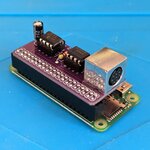twelvetone12
Well-known member
Yes it is on wifi  OS X does some weird prioritizing/ throttling, this is not the first time it happens to me. Will try via Ethernet or on Linux and see.
OS X does some weird prioritizing/ throttling, this is not the first time it happens to me. Will try via Ethernet or on Linux and see.
Glad you figured it out! CTS is indeed crucial to TashTalk's proper functioning, the PIC has a buffer of only 128 bytes for inbound data and if it overflows, the wheels start to come off pretty quickly.I grabbed a proper usb adapter with CTS, plugged it in and... it works! :O
Essentially, yes. The core LocalTalk functionality is the same across versions, so really, you should use whichever version makes sense for your particular application:I have another small question: should I stick with v 1 or should I try version 2? If I understand correctly, the only difference is that the LT IO is multiplexed in one pin right?
For your application, you're effectively pretending that the Mac is on a two-node (physically) LocalTalk network, so it seems like using 1.0 makes the most sense - connect the PIC's LT input to the Mac's Tx line and the PIC's LT output to the Mac's Rx line and leave driver enable unconnected. If you used 2.x, you'd need to do something with transistors to ensure that you didn't get into a situation where both the Mac and the PIC were driving the line at the same time.How should this look on the final circuit, I was thinking of adding a couple transistors to DE so only TX or RX from the mac is connected at a given moment.
Victory not so much - there seems to be major issues (likely not HW) with the solution. Very flakey - it's worked once (and a 1/2) and failed otherwise. Not sure what's going on.Victory! \o/
I have another small question: should I stick with v 1 or should I try version 2? If I understand correctly, the only difference is that the LT IO is multiplexed in one pin right? How should this look on the final circuit, I was thinking of adding a couple transistors to DE so only TX or RX from the mac is connected at a given moment.
It sounded earlier like your issue was a loose connection with the DIN plug. Has that changed?Victory not so much - there seems to be major issues (likely not HW) with the solution. Very flakey - it's worked once (and a 1/2) and failed otherwise. Not sure what's going on.
Oh damn I didnt get this notification since I use the 65HVD08 extensively in my product line, the DIP version.Anyone else want one of the TashTalk Hat 2.x kits? I will have three more to sell once my Digikey order with the transceivers arrives.
Sadly, TI is discontinuing their line of RS422/485 transceivers in DIP packages this November, so this hat design is going to have to be replaced with one that uses surface-mount chips at some point. I really should learn how to do SMT soldering. Boo, hiss.
Anyway, kits available for $12 each (my approximate cost), plus shipping. Slide into my DMs. =)

Would anybody be interested in a localtalk to USB adapter? It would be very easy to make, and probably those cheapo USB to serial adapters would work. Then tashtalk then the transceiver and and connectors.
It might be a little scope-creep-y, but I like the idea of a USB PhoneNet box, basically what you described except with a transformer built in and 4P4C connectors instead of a mini-DIN.
Oh, cool! I didn't know such a thing existed. Does the integrated transformer meet the specifications to interoperate with LocalTalk?Or just use something like this instead of transformers? https://www.analog.com/media/en/technical-documentation/data-sheets/ADM2485.pdf
